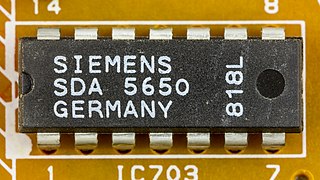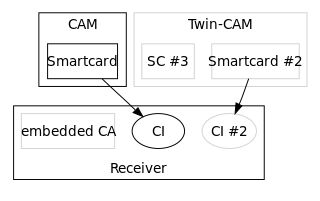
Digital Video Broadcasting (DVB) is a set of international open standards for digital television. DVB standards are maintained by the DVB Project, an international industry consortium, and are published by a Joint Technical Committee (JTC) of the European Telecommunications Standards Institute (ETSI), European Committee for Electrotechnical Standardization (CENELEC) and European Broadcasting Union (EBU).
DigiCipher 2, or simply DCII, is a proprietary standard format of digital signal transmission and it doubles as an encryption standard with MPEG-2/MPEG-4 signal video compression used on many communications satellite television and audio signals. The DCII standard was originally developed in 1997 by General Instrument, which then became the Home and Network Mobility division of Motorola, then bought by Google in Aug 2011, and lastly became the Home portion of the division to Arris.

Programme delivery control (PDC) is specified by the standard ETS 300 231, published by the European Telecommunications Standards Institute (ETSI). This specifies the signals sent as hidden codes in the teletext service, indicating when transmission of a programme starts and finishes.
Digital Video Broadcasting – Satellite (DVB-S) is the original DVB standard for Satellite Television and dates from 1995, in its first release, while development lasted from 1993 to 1997. The first commercial applications was by Star TV in Asia and Galaxy in Australia, enabling digitally broadcast, satellite-delivered Television to the public.
DVB-T, short for Digital Video Broadcasting — Terrestrial, is the DVB European-based consortium standard for the broadcast transmission of digital terrestrial television that was first published in 1997 and first broadcast in Singapore in February, 1998. This system transmits compressed digital audio, digital video and other data in an MPEG transport stream, using coded orthogonal frequency-division multiplexing modulation. It is also the format widely used worldwide for Electronic News Gathering for transmission of video and audio from a mobile newsgathering vehicle to a central receive point. It is also used in the US by Amateur television operators.
DVB-C stands for "Digital Video Broadcasting - Cable" and it is the DVB European consortium standard for the broadcast transmission of digital television over cable. This system transmits an MPEG-2 or MPEG-4 family digital audio/digital video stream, using a QAM modulation with channel coding. The standard was first published by the ETSI in 1994, and subsequently became the most widely used transmission system for digital cable television in Europe, Asia and South America. It is deployed worldwide in systems ranging from the larger cable television networks (CATV) down to smaller satellite master antenna TV (SMATV) systems.

Digital Video Broadcasting - Satellite - Second Generation (DVB-S2) is a digital television broadcast standard that has been designed as a successor for the popular DVB-S system. It was developed in 2003 by the Digital Video Broadcasting Project, an international industry consortium, and ratified by ETSI in March 2005. The standard is based on, and improves upon DVB-S and the electronic news-gathering system, used by mobile units for sending sounds and images from remote locations worldwide back to their home television stations.

A single-frequency network or SFN is a broadcast network where several transmitters simultaneously send the same signal over the same frequency channel.

High-Efficiency Advanced Audio Coding (HE-AAC) is an audio coding format for lossy data compression of digital audio defined as an MPEG-4 Audio profile in ISO/IEC 14496-3. It is an extension of Low Complexity AAC (AAC-LC) optimized for low-bitrate applications such as streaming audio. The usage profile HE-AAC v1 uses spectral band replication (SBR) to enhance the modified discrete cosine transform (MDCT) compression efficiency in the frequency domain. The usage profile HE-AAC v2 couples SBR with Parametric Stereo (PS) to further enhance the compression efficiency of stereo signals.
MPEG transport stream or simply transport stream (TS) is a standard digital container format for transmission and storage of audio, video, and Program and System Information Protocol (PSIP) data. It is used in broadcast systems such as DVB, ATSC and IPTV.

In Digital Video Broadcasting, the Common Interface is a technology which allows decryption of pay TV channels. Pay TV stations want to choose which encryption method to use. The Common Interface allows TV manufacturers to support many different pay TV stations, by allowing to plug in exchangeable conditional-access modules (CAM) for various encryption schemes.
Program-specific information (PSI) is metadata about a program (channel) and part of an MPEG transport stream.
Packetized Elementary Stream (PES) is a specification in the MPEG-2 Part 1 (Systems) and ITU-T H.222.0 that defines carrying of elementary streams in packets within MPEG program streams and MPEG transport streams. The elementary stream is packetized by encapsulating sequential data bytes from the elementary stream inside PES packet headers.
IP over DVB implies that Internet Protocol datagrams are distributed using some digital television system, for example DVB-H, DVB-T, DVB-S, DVB-C or their successors like DVB-S2. This may take the form of IP over MPEG, where the datagrams are transferred over the MPEG transport stream, or the datagrams may be carried in the DVB baseband frames directly, as in GSE.
BiM is an international standard defining a generic binary format for encoding XML documents.
ATSC-M/H is a U.S. standard for mobile digital TV that allows TV broadcasts to be received by mobile devices.

The ABNT NBR 15603 is the technical document of the SBTVD standards that describes in detail aspects regarding Multiplexing and service information (SI). The document is divided in 3 separate parts that covers: SI for digital broadcasting systems ; Data structure and definition of SI basic Information ; and Syntax and definition of SI extended information.
ISO/IEC base media file format defines a general structure for time-based multimedia files such as video and audio. The identical text is published as ISO/IEC 15444-12.
Generic Stream Encapsulation, or GSE for short, is a Data link layer protocol defined by DVB. GSE provides means to carry packet oriented protocols such as IP on top of uni-directional physical layers such as DVB-S2, DVB-T2 and DVB-C2.
OpenCaster is a collection of open-source and free software for the Debian GNU/Linux system to play out and multiplex MPEG transport streams. OpenCaster generates most of the non audio/video data present into transport streams and handle playout of pre-encoded audio/video files or can be integrated with third parties audio/video encoders.






